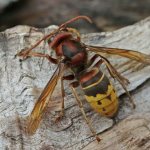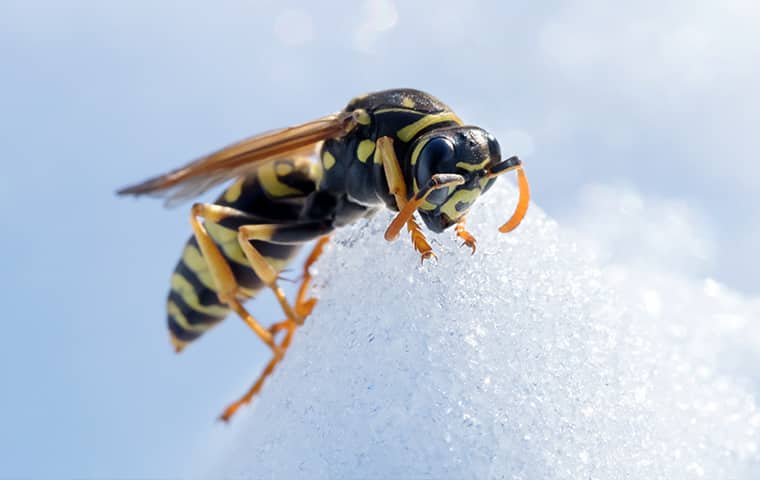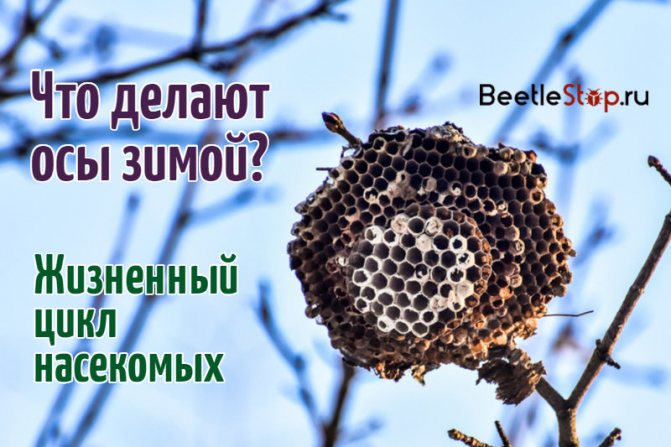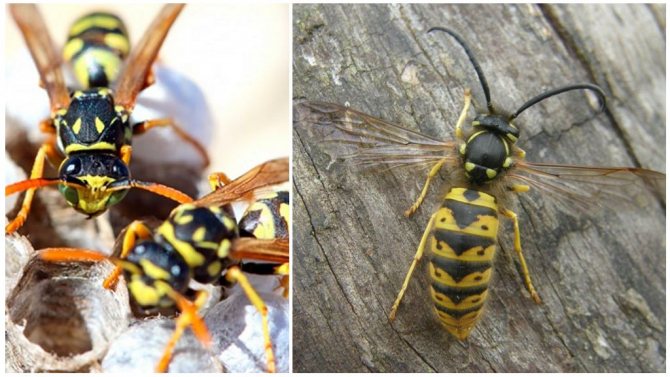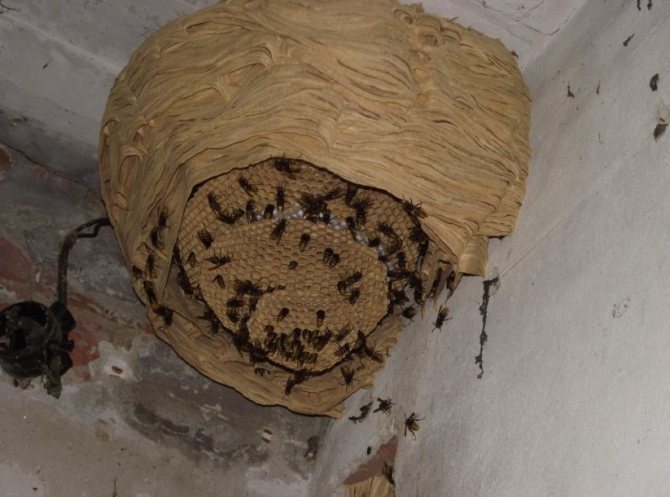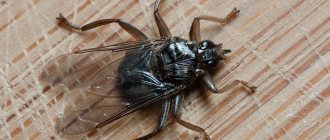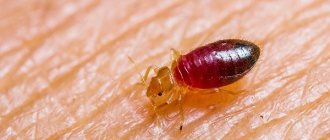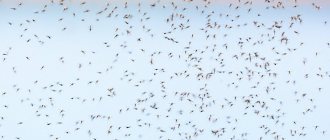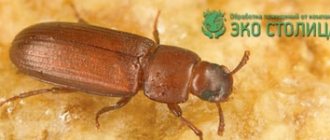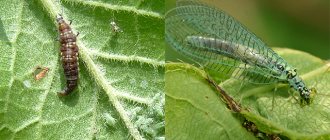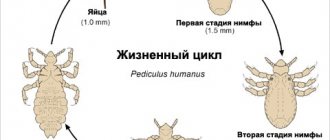A little about hornets
Hornets are very large wasps up to 5.5 cm long. They live in colonies of up to 400 individuals. They build horizontally located nests, which are honeycombs in several rows of five hundred cells each.
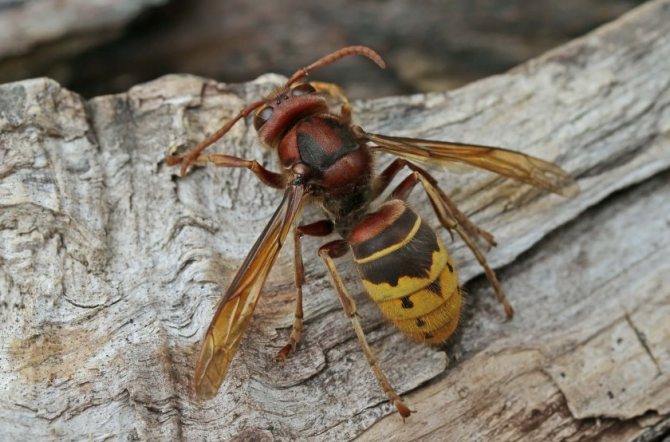
Giant wasps set up their homes in warm places that are protected from wind and rain. More often they prefer the neighborhood with a person, as they like to eat the remnants of human products. They also eat other smaller insects, rotting fruits, drink plant sap.
Insect wintering
The peculiarity of hornets is that they lack thermoregulation. With the onset of cold weather, they need to safely hide and fall into a daze. Otherwise, insects die.
Nest device for the winter
Insects build their dwellings from wood ground by jaws, mixed with saliva. To protect against temperature extremes and other negative factors, the cells themselves, in which the larvae develop, are wrapped in a woody mixture resembling a paper cocoon.


The nest often resembles a pear or a ball in shape. Differs in amazing symmetry and precision of shapes.
The larger the diameter of the wasp house, the more individuals live in it. The ability to build nests is genetically transmitted to each generation. Fertilized female - the uterus wakes up after hibernation and chooses a place for the future residence of the entire swarm.
There she attaches the base and makes several (3-5) first cells. Eggs are laid in them, the first larvae develop, from which the working representatives of the genus emerge. They also finish building the hive afterwards. Nests are used only in warm seasons for rearing larvae in combs.
Wasps settle in secluded places:
- hollows;
- burrows of animals;
- under the roofs of houses;
- in the cracks of the trunks;
- in the crevices of the rocks.


Wasps leave the house for the winter. Those individuals that are going to overwinter do not specifically prepare the hibernation site in any way. It is simply chosen so that no one finds the insect and does not accidentally destroy it. One should not be afraid that the wasp will decide to wait out the frosts in a warm human house.
When and how to hibernate
In the middle of autumn, the hornets leave the nest and begin active mating. With the onset of frost, they cannot maintain their metabolism and in order to survive, they hibernate. Only fertilized female hornets settle down for the winter.
The queen, drones and workers simply die. The liquid in the insect's body is represented by glycerin. Thanks to this, it does not turn into a piece of ice at sub-zero temperatures and is able to warm up and continue to function with the arrival of spring.


Where they hibernate
Females settle for the winter in a cold place. These can be unheated abandoned rooms, recesses between bricks in the outer part of the walls of residential buildings, hollows, cracks in the bark, burrows, places under large stones.
Outcome
We have considered only the most interesting facts from the life of wasps.
These insects, of course, bring many benefits to people - they destroy flies and garden pests. But they are the bees' worst enemies and are a threat to apiaries. In addition, a wasp sting causes a severe allergic reaction, and sometimes death.
Wasps
How to get rid of a wasp nest under the roof of a country house? V. Chekhun. Lomonosov
First, let's figure it out: what kind of wasps are they and should we get rid of them? Most often, paper wasps live under the roofs of summer cottages. They are so called because the substance from which they build nests is made according to the same principle as paper: the small fibers of the wood of the wasps are rubbed with their jaws and moistened with saliva. Although it is believed that there is no harm from them, I have seen fences and walls of country houses gnawed by wasps in places where they are especially widespread.
The presence of wasps in a garden plot can be of some benefit: this predatory insect brings flies, caterpillars, beetles, sawfly larvae and other garden pests to feed its larvae. However, the effectiveness of wasps in the fight against insect pests is low, and they will be successfully replaced by specialized entomophages.
Adult wasps feed on flower nectar, sweet apples, raspberries, gooseberries, pears, and grapes. They are especially attracted by burst, overripe berries: During foraging, wasps are not too aggressive, they can be driven away. But during the period when the wasps are in the nest, they can attack without any reason on your part.
You can often hear such recommendations: "do not touch the wasps without reason, and if the wasp starts circling around you, stand still and it will lag behind." In practice, everything is different. Since the wasp does not leave a sting in the wound, then, unlike a bee, it can sting several times in a row, and after being bitten it does not die, so the decision "to bite - not to bite" she often takes in favor of the former.
Therefore, if wasps settled next to you - know: one day you will be bitten. It is definitely necessary to get rid of the wasp nest, especially if someone in the family is allergic to Hymenoptera bites.
Shooting down old large nests in late autumn or winter, which is often done in summer cottages, is an energetic but pointless exercise. Such nests have already served; wasps do not hibernate in them. With the onset of frost, working wasps and their larvae die, and the founding females hide in cracks for the winter in order to start building a new nest in the spring.
In the spring, you should carefully inspect the attics and verandas from the inside - if there are any new small nests, they are at this time the size of a walnut. When you find such a nest, quickly remove and destroy it. Having returned, the female will twist a little and, not finding her house, will fly away to another place. Thus, you will get rid of wasps in the country for the whole summer. Sometimes especially stubborn females build five or six houses in a row in the same, apparently, favorite place. But be more persistent - having lost another house, the insect will decide to move to a safer place.
But if your dacha is far from the city, and you yourself are not afraid to take risks, then you can use the old proven method. To do this, you need to pick up equipment: gloves, several layers of thick clothing (a quilted jacket or army pea jacket is ideal), a mesh on the face and a long stick. It is necessary at night (when the wasps are sleeping, preferably at 3-4 o'clock), collect boiling water in a bucket (the water should reach almost to the brim), put the bucket under the nest and knock it down directly into the boiling water with a stick, and then quickly cover it with a lid so that the wasps are boiled. If it's scary to touch the nest, you can simply cover it with a tight bag or bag containing cotton wool soaked in insecticide and keep the bag closed until all the wasps are dead.
Another method that I have used repeatedly: processing with dichlorvos. It is better to do this at night too, but with sufficient skill you can cope during the day. The dichlorvos can is placed against the hole of the nest and the whole is etched away (it will take from 3 to 5 minutes), while trying to turn it so that the aerosol gets into all the layers of the paper. This method is good if the wasps have settled under a beam or in another hard-to-reach place, and it is not possible to knock down the nest quickly. Be sure to protect your face and hands when using this method as well.
O. Vershinina
Hornet control in winter
What is called the fight against insects in winter is only the actual destruction of their old nesting site. Most of them die naturally with the arrival of cold weather. The surviving individuals fall into suspended animation one by one outside the walls of a human house.
The female wakes up in spring when the air temperature reaches + 10 ° С. At this time, her task is to build honeycombs and breed offspring. Hornets are an important part of the ecosystem. Having found a womb sleeping in winter or somewhere hurrying in spring, you should not kill her. In some regions of the planet, the species is listed in the Red Book.


If there is a hornet nest within sight (for example, under a roof), it causes certain fears and negative emotions. Such a structure can be safely removed in winter. However, in fact, it does not pose any threat to humans. Next time the swarm will build a new dwelling.
Giant wasps have controversial meanings to humans:
- Bees are killed.
- Their bites are painful and can cause severe allergies.
- They devour harmful insects (aphids).
- They eat organic residues, thereby clearing the territory.
Hornets are not afraid of a person, but they do not specifically attack him. They can only sting if they feel threatened by themselves or their offspring. They can regard it as a dangerous signal and carry out an attack at the sight of fluttering hair, clothes, dead insects.
Also, obsessive interest can be caused by food with a banana and apple smell and the presence of alcohol or ether. Nevertheless, in the summer and until mid-autumn, it is advisable to have an antihistamine with you so that a sudden collision with a stinging insect is as safe as possible.
How to destroy a hornet's nest
Often in the country you can see hornets' nests. Wasps cause inconvenience not only to humans, but also to plants. They are capable of carrying various infections, often of an intestinal nature. These insects also threaten the harvest, especially if grapes grow on the site.
HOW THE AXLE NEST APPEARS
Nests are built by sterile females, they worry about their queen and her offspring, protecting them from outsiders. Chewed natural material is used for construction. Usually wasp nests are in a dry, dark place (tree, attic, hollow). Wasps love sweets (drinks, honey, watermelon, jam and much more), flower nectar and ripening fruits. Wasps often take honey from bees.
HOW TO DESTROY THE AXLE NEST (MOST EFFECTIVE WAY)
Wasps bring a lot of trouble to humans, and in order to get rid of them, you need to destroy their nests.
It is very important to observe safety precautions here, otherwise, with a careless action, there is every chance of being bitten. It is better to clean the wasp nest in the fall or, if you need to act urgently and there is no way to wait, only at night, when all the individuals are in place and at the same time sleep
It is extremely unsafe to carry out such an operation during the day. Before entering the "battlefield" put on protective clothing, the best option would be a beekeeper's suit, but not everyone has one, so wear everything that can cover all parts of the body. Use a mesh for your face. Think about how you can quickly help in case of defeat.
Another effective way to destroy a hornet's nest is to take a plastic bag, treat it with karbofos or any other insecticidal preparation, very quickly pull it onto the nest and cut off its attachment. Then tie the bag tightly and leave for several hours. Treat the attachment point with insecticide or hydrogen peroxide. If you cannot cut off the nest, then the processed bag is attached with tape from above. Only the package must be tight, otherwise insects will gnaw it. Treat the area around the nest with an insecticide.
Before carrying out an operation to destroy the wasp nest, it is recommended to first reduce the number of individuals. To do this, treat the nest with the Moskitol chemical or any other designed to combat wasps, it will be good if the drug stream can be directed directly into the nest itself and the outlet is quickly plugged with a rag treated in the same preparation. For safety, wear a mosquito net and gloves over your face.
Remember to wash your hands well with soap and water after using chemicals.
When, destroying wasp nests, it still could not do without a bite, then it is immediately necessary to take an antihistamine (suprastin), and to relieve puffiness, apply a cotton pad dipped in ammonia diluted with water (1: 5) to the bite site.
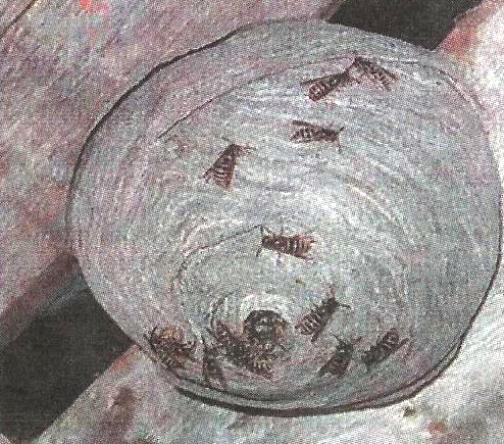

FROM OS BURNING OUT
Fill the hornet's nest with gasoline or any other combustible and burn it. The method, of course, is inhuman and ineffective. It can only be used in non-residential premises and not in trees.
TRAP AND OTHER WASP CONTROL DEVICES
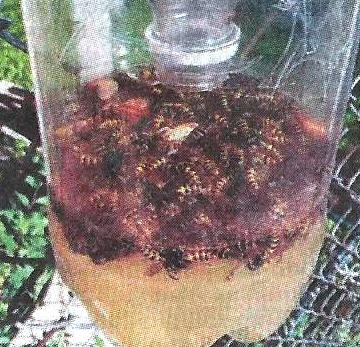

Traps are especially convenient to use in those places where the approach to the wasp nest is difficult, thus it is possible to reduce the number of individuals, but it will not be possible to destroy the nests. In this case, syrup and honey cannot be used, since bees will begin to fly along with the wasps, which will also die. In traps, use only fermented foods, old jam. Change the contents of the traps regularly.
1. Treat the peels from watermelon or melon with insecticidal preparations that do not have a pungent odor (Lambda-Zone, Delta-Zone, Smelnet), spread them near a compost heap or a wasp nest. Wasps will fly to the smell and die from eating processed food.
2. Cut the neck off the plastic bottle, insert it into the ground, pour the spoiled compote and add boric acid to it. Once trapped, it will be difficult for the wasps to get out of it, and those who do manage to do so will not have long to live, about 2 hours.
3. Apply medium thickness glue to a piece of cardboard, and place a piece of meat or spoiled fruit in the center. Wasps will start to fly in and stick to the cardboard.
4. Many summer residents, if the hornet's nest is in the ground, pour boiling water in a large volume (about a bucket), after which they cover the hole with earth and tamp it well. You can put a piece of roofing material on top, then press it down with stones or bricks.
Wasps in the spring can return again without finding their home, they will begin to build a new one next to the old one. Therefore, the entire area near the nests must be treated with kerosene or an insecticidal agent, for example, "Sinuzan".
Where hornets winter and the diet in winter
Hornets are insects similar to common wasps, but differing in their larger size. These insects are considered dangerous because they bite very painfully, and if a person has a tendency to allergies, then after such a bite, it is likely that Quincke's edema or anaphylactic shock will develop.


Physiologically, hornets are designed in such a way that they cannot regulate their body temperature, which means that with the onset of cold weather, they must die. But nevertheless, they spend the winter somewhere and appear in the spring, begin vigorous activity on arranging nests, breeding offspring, etc. In this regard, it is very interesting where hornets winter, how they manage to protect themselves from cold and dampness.
Hornets are close relatives of common wasps, they have a similar body structure, nutritional and vital functions, reproduction and distribution. But nevertheless, in some ways, hornets differ from their relatives, for example, wasps always use their sting, both in self-defense and when foraging. And hornets use their poison solely to protect themselves, and they kill insects for food with their jaws.
Wasps attack people for no reason
Wasps are considered one of the most dangerous insects, stinging their prey. Like everything related to stinging, the wasp is considered a predator, the bite of which brings a lot of pain. After a bite, a person feels severe pain, after which other unpleasant symptoms may appear.
The first reason why wasps attack is an attempt at defense. Like any predator, the wasp is evil by nature, so any encounter with it is perceived as an attack. Usually such encounters only end in bites.
The distinguishing signs of a wasp bite are:
- Instant redness and swelling of the bite site;
- The pain is complemented by severe itching;
- The appearance of an allergic reaction;
- The whole body begins to itch, a rash appears;
- In the place where they stung, pain of an acute nature appears;
- Anaphylactic shock.
Additionally, there may appear:
- severe dizziness;
- vomiting, nausea;
- acceleration or deceleration of the heart rate;
- increase in temperature.
Note! The most dangerous symptom is considered anaphylactic shock, into which allergy sufferers most often fall. Moreover, if qualified medical care is not provided for a short time, a person may die from a wasp sting
How hornets live
Many people associated with agriculture, as well as beekeepers, gardeners, are interested in where hornets live in nature, how and what they eat, how dangerous they are for humans and for the harvest. It is typical for hornets to live in colonies, in large concentrations. In one family of these insects, there are sometimes more than 400 individuals. The main position, as a rule, is occupied by the uterus, which is responsible for laying eggs and breeding new offspring.
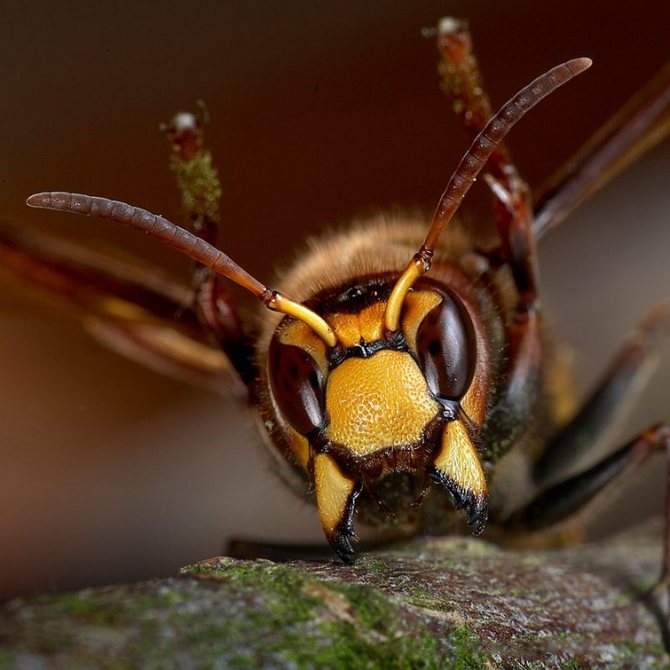

Interesting fact! In order to prevent mating of males with other females, the uterus exudes a special smell. As a result, drones are born, which hatch from the unfertilized eggs of other females.
Body structure


Features of the body structure of an adult:
- The length of the uterus is approximately 30 mm, while that of males and other individuals is 25 mm.
- The head and chest are yellow.
- There are three reddish eyes on the head.
- Powerful mouth apparatus, like a gnawing insect.
- Characteristic color in the form of yellow rings with brown splashes.
- Villi all over the body.
Hornet species
The most common species of hornets is European, living in places where there is agriculture, as well as in forests, in thickets of plants. This type of insect does not like dry and cold climates, so they cannot be found in the cold North and in the southern regions with a dry climate.
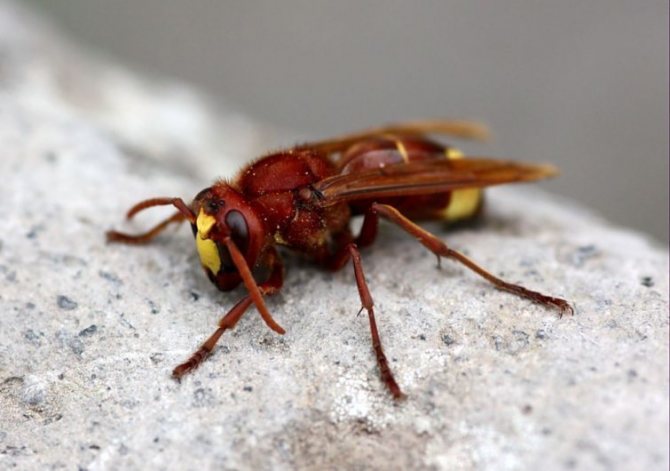

The eastern hornet lives in Asia, Madagascar, North Africa, and is also often found in Europe, but exclusively in its southern part. Only this species of hornets can live where it is dry and hot, in deserts and semi-deserts, in the steppes. They place their nests in the ground, have a red-brown color.
Filipino hornets are considered the most dangerous and poisonous, since a person can die from their bites. They live only in the Philippines.
Where hornets live
Hornets form their nests from wood, birch bark. Their building material is peculiar: they chew on wood with powerful jaws and make dwellings for themselves from the resulting mass.
Diversity of wasps in nature
There are a huge number of wasp species in the world. All of them belong to the order of Hymenoptera insects with two pairs of wings. The size of adults is from 10 to 55 mm, and the males are smaller than the females. Their mouthpieces are made of strong jaws, capable of tearing apart prey and gnawing at a layer of bark from trees. A distinctive feature of wasps is a thin stalk between the chest and abdomen, a kind of wasp waist.
All insects belonging to this family can be divided into two main groups: solitary and social wasps.The former lead a solitary life, often build nests in the ground or do not build at all, preferring to lay eggs on larvae and spiders. Public or paper wasps are common striped individuals that buzz around gardens and parks. They live in colonies from several tens to thousands of individuals.
Where do wasps hibernate, do they sleep in winter or die?
Often, wasps build a nest under the roof of a house in a summer cottage, in a basement or on a balcony. This causes a lot of inconvenience and is dangerous to health, because the swarm can attack, sting and spoil the food. It is difficult to cope with this scourge in the summer, the wasp brotherhood does not sleep and rebuffs everyone who tries to attack their home. And with the onset of cold weather, the nest becomes empty. To drive away dangerous insects once and for all, you need to figure out where the wasps spend the winter and whether they will return to their homes after winter. Do I need to destroy an empty nest?
Do wasps die in winter?
In autumn, the wasps leave their nest and disappear for several months. If it remains in the same place, then the first individuals will begin to return in the spring. They also begin to disappear gradually, young females disappear in October, when the temperature in the Moscow region drops to +10 degrees.
Working females are the first to die. Their life cycle is short, only a year. Before that, at the end of summer, individuals capable of giving birth to offspring mate. Then they fall into suspended animation and fall asleep until spring in order to preserve future offspring during the frost period. By the end of November, workers and males die. The old uterus falls asleep forever, in the spring a new individual will take its place. Some families give birth to fertile females only at the end of August, so their cycle is slightly shifted. At the end of summer, life processes inside the wasp organism begin to slow down until they slow down so much that the insect freezes and hibernates with a lethal outcome.


As a result, only females that store eggs survive the winter. In the spring, the swarm will recover and return to its former place of residence. In single species of wasps, the uterus with offspring inside survive the winter. Male hornets die in winter, and females hide until warm days and survive. Wasps choose wintering places long before the onset of cold weather.
The main distinguishing feature
The life of a wasp depends on whether it belongs to social individuals or solitary ones. Already from the name it becomes clear that the former live in families, and the latter - separately. This division exists in all the many species of insect. Each single individual has the ability to reproduce. In the family, only the uterus continues the lineage.
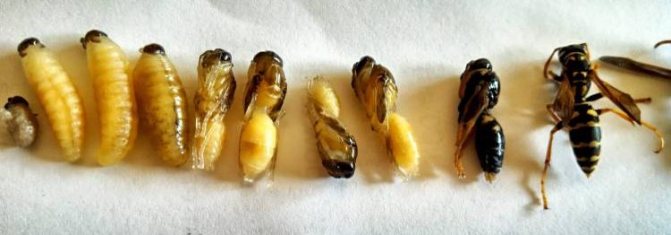

Single wasps, prefer not to live in a large company. They mate and then lead a solitary life. Paper single female individuals build their nest. In each cell, in addition to the laid egg, the female places a supply of food for the poor larva. These are small insects and spiders paralyzed by poison. After filling the cell, the female seals it.
The larva eats the reserves prepared by the caring mother and develops inside the cell. When it reaches maturity, it gets out of the nest on its own. Young insects scatter in search of a place to build their own "home".
Spring chores of public wasps
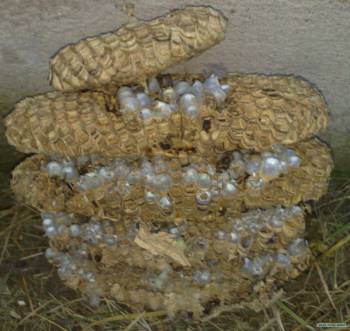

The female of the social species is fertilized by the male only once. After wintering, she begins to look for a suitable place for a "family nest". It could be a branch of a tree or the ceiling of a building. In the spring, she has to build several cells, which she will connect to each other - this is how honeycombs are obtained. She lays one egg in each cell.
The eggs develop very quickly - in about a week. The queen feeds the larvae that emerged from the eggs with chewed insects. The larvae, having collapsed with cobwebs, turn into pupae. A few days later, working wasps emerge from the pupae - these are sterile female individuals. Already in July, they take on the responsibility of completing the "house", taking care of the mother and the larvae.
From this time on, the uterus is engaged only in laying eggs. After all, she needs to set aside about 300 pieces a day. In addition, she closely monitors the order in the house. Often it stings workers who do not perform their duties well. All working wasps are sisters among themselves, and the female collective needs an eye and an eye.
Summer-autumn period
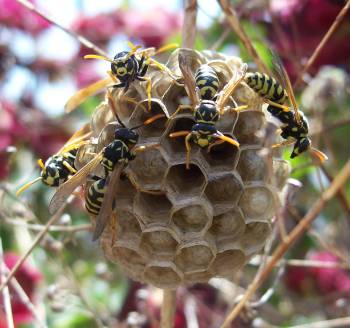

Experts say that it is from the food that the larva eats that determines who will appear from it - a working disembodied individual, or a female or a male. The uterus lays eggs only at the end of summer, from which insects capable of reproduction will hatch. They are fed food that promotes the development of their genitals.
What does it consist of? It can be chewed pieces of leaves and other plant foods, as well as "meat" in the form of various insects. In particular, flies, beetles, spiders, etc. The wasp larva does not leave the cell until it becomes an adult. Having reached maturity, insects swarm and mate with each other. So, the life cycle begins anew.
Hibernation


Not all wasps hibernate in winter, but only young fertilized females. Males die after fertilization. With the onset of cold weather, the wasp family perishes, which has already been abandoned by young female and male individuals. Essentially, the old queen and the worker wasps that lived in the nest die.
Indeed, the life expectancy of working individuals is only 4 weeks. Then, as the uterus wasp lives for 10 months. Young females, leaving their father's house, are looking for a place where they can comfortably winter. After finding a warm secluded place, they fall asleep. In order for the insects to wake up, the onset of spring heat is necessary.
We have considered only the most interesting facts from the life of wasps.
These insects, of course, bring many benefits to people - they destroy flies and garden pests. But they are the bees' worst enemies and are a threat to apiaries. In addition, a wasp sting causes a severe allergic reaction and sometimes death.
Where do they spend the winter?
After fertilization, instinct stimulates females to find suitable housing in which they will spend the winter. Wild wasps choose places that are able to keep warm. A reliable shelter is the bark of trees, in which insects gnaw holes. The walls of the winter dwelling were impregnated with saliva. From this, they are strengthened in order to further protect the sleeping inhabitants from bad weather and attack. After that, they fill it with food reserves for the winter, so that there is something to feed the offspring. Public wasps (paper wasps are their second name) accumulate nutrients throughout the summer in the body, and in winter they do not wake up for snacks. Wasp shelters in winter often include old tree stumps, stocks of firewood stacked for building boards, and wooden decks under the roof. Slots in the walls of residential buildings, which are regularly heated in winter, are also suitable.
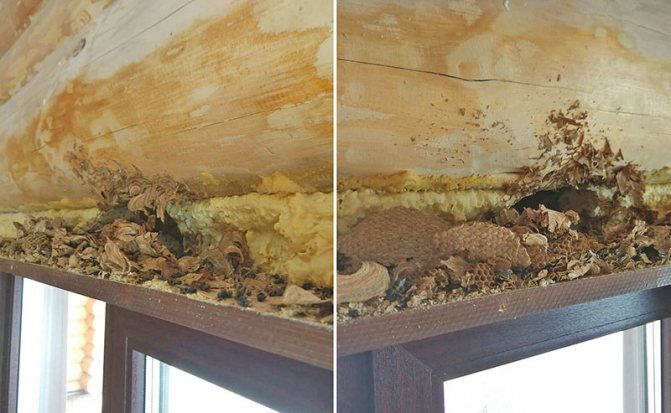

It's good if a snowy winter comes. The wasp shelters are covered with snow and the females will calmly survive the cold. But if the weather is rainy, water gets into the holes and insects die.
Expert advice: to get rid of these pests on the site, you must try to find winter shelters and destroy. Because if this is not done, but simply to destroy the empty nests, an unpleasant surprise may await the owners in the country house in the spring.
Preventive measures against annoying neighbors
Paper wasps are troublesome neighbors. They spoil the fruit on the trees, bite people, intrusively climb on sweet food. To reduce the likelihood of their settlement near the house or under its roof, it is advisable to destroy the nest. Knowing what wasps do in winter, you can safely cut the structure and burn it. At this time, you do not run the risk of getting a stinging insect bite. Females do not settle in the old nest, but build a new one in their usual place. If you process the site where the building was located with an unpleasant smelling compound (kerosene, engine oil, dichlorvos), then the uterus will fly away to seek a more suitable refuge.
To deprive the wintering wasps of shelter on the site, certain work should be done:
- collect and burn dry foliage;
- remove rotten stumps, cut trees;
- do not leave boards, slate sheets on the ground, under them insects seek refuge for the winter;
- pour boiling water over compost heaps;
- you can start preparing the material for the traps that will be needed to protect the crop.
Fighting stinging insects after the onset of cold weather is absolutely safe. They stay in a state of diapause until April-May. Only with the onset of warmth (+14 0) will the uterus wake up and start creating a new colony. Preventive measures can help reduce the number of insects surviving into spring.
Features of life next to a person: how do hornets winter?
How do hornets winter - those same giant wasps that bite so painfully? After all, these insects belong to those animals that are not able to maintain a high temperature of their body. According to the logic of the physical body, insects should become a piece of ice at subzero temperatures.
However, every spring, hornets fly out from somewhere, starting a vigorous activity for their food and reproduction of offspring. How do they manage to winter, where do they hide from the cold weather, and most importantly - why do they not turn into this very piece of ice?
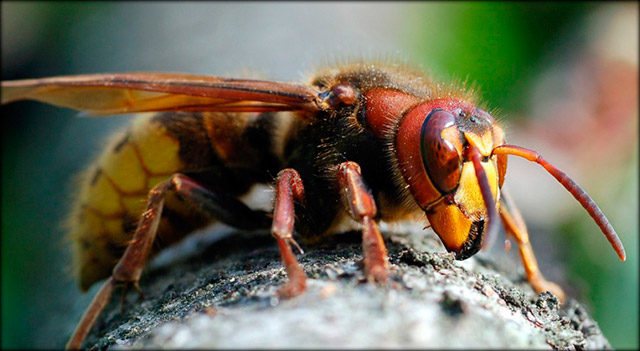

Who are they - hornets?
In biological taxonomy, there is a special genus called hornets. He, in turn, is part of a family called true wasps. So the hornets are not in vain so similar to wasps. These are their closest relatives, who do not differ much from the so-called paper wasps in their lifestyle, reproduction and feeding method. Nevertheless, hornets still have their biological and behavioral characteristics.
Usually these insects are one of the largest representatives of the wasp family, live in different biotopes and are not directly associated with human dwellings and agricultural lands.
What are these big wasps eating?
These insects can be called omnivores, but nevertheless, according to their habits and predilections, they are, first of all, predators that feed mainly on other insects. However, their behavior is complex, their character is decisive, their habits are unusual. These intelligent, brave to the point of insolence, insects do not shun theft and robbery. By the way, they get food without using a sting. For this, they have enough powerful jaws. A sting with poison exists for self-protection from large animals.
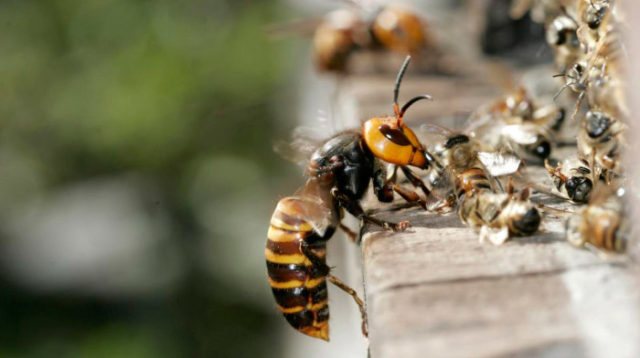

The hornet is the worst enemy of bees, capable of destroying an entire hive in a squad of several individuals. After that, the robber eats and takes to his nest everything that he finds in the empty dwelling.
Adults also feed on the fruits of some plants. They are very fond of the juice of berries, mainly raspberries, blackberries, strawberries, grapes. Even more, they prefer to feast on sweet fruits, such as peaches, apricots, and plums.
These insects are especially fond of overripe fruits and berries that begin to decompose. In addition, they flock to the corpses of recently deceased animals, in whose bodies maceration has already begun, but the decay process has not yet taken place.


Wasp life cycle, lifestyle
Everyone has come across wasps at least once and is well aware of their aggressive nature. The insect, without hesitation, will attack first if it senses danger. Predators are able not only to sting, but also to bite with their jaws, which in itself is less painful. The family also has a herd instinct. If there are wasps nearby that sense the poison, they will come to the rescue and help attack.
The entire short life cycle of insects can be divided into several stages:
- Birth and arrangement of the nest. With the arrival of warmth, the uterus begins to nest to give life to a new generation;
- Reproduction. After laying eggs, fertile males and females appear, providing further reproduction.
Hornet and man
The hornet does not specifically touch a person, but he is not afraid either. He settles next to people, because it is more convenient to build nests here. And there is also a lot of food here, since various insects are always concentrated around a person. Moreover, human stocks are the source of food for the hornets themselves. For example, an adult under a person's nose can fly up to a piece of meat from which a cutlet is made, cut off a small piece for itself and fly away with the prey in its jaws. There is no such abundance of food anywhere in the forest.
However, living next to a person is dangerous. He is the only mammal that deliberately ravages the nests of these predators.
Thus, for this large wasp, a person is a creature that:
- builds structures convenient for nests;
- concentrates a lot of insects around itself;
- grows delicious fruits and berries;
- stores stocks of energetically saturated food;
- breeds bees.
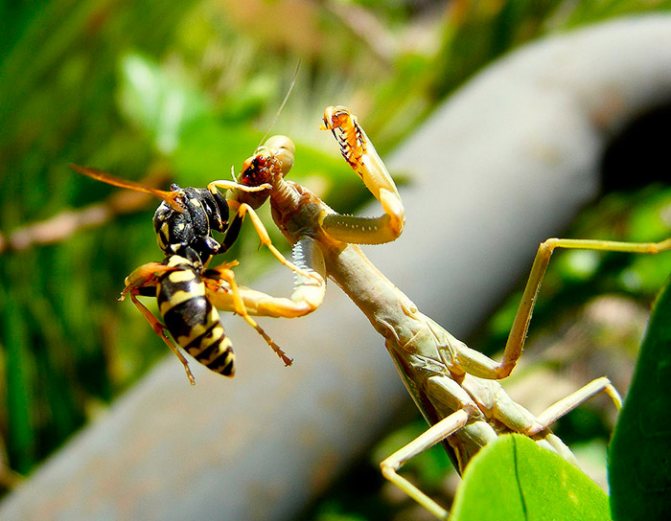

Hornets also play a contradictory role in human life. They are:
- bite painfully;
- destroy insects - agricultural pests;
- cleanse areas of rotting products;
- destroy bees.
So for humans, hornets are such neighbors on the planet that both help and harm. If you do not breed bees, then these large wasps that have settled near human dwelling are more useful than harmful. But beekeepers with hornets have their own scores.
Variety of species
Wasps familiar to most of us, having stripes of yellow and black on their bodies, are called paper wasps. This name of the species is due to the fact that the material from which insects build their homes is very similar to paper. It is made of wood fibers chewed by arthropods, which are glued together with saliva.
Other wasp species have a different color. The size of the insect depends on its species. They range from 1.5 cm to 10 cm. What do wasps eat? An adult eats mostly liquid food - nectar, fruit juice. Wasps extract for their larvae: flies and other insects. Predatory wasps themselves eat insects, and they can also eat other types of food.
The wasp catches its prey and injects its poison into it through the sting, which does not kill, but only paralyzes. Thus, the meat of the prey is kept fresh until the moment of the meal.
Different types of wasps live almost everywhere. For example, earthen wasps choose soil for the construction of their "houses". Paper wasps build their "family nest" under a tree branch or on any structure. It should be noted that wasps are eager to settle next to people. This neighborhood makes it much easier for them to find food.
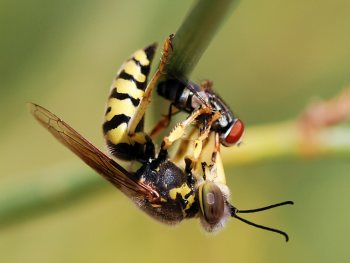

The wasp eats sweets and other foods left in a prominent place in a person's dwelling. But also, she catches there such pests as flies, which carry various infections and thus benefit. In the garden, wasps can find not only flies and ants, but a huge number of insects that are pests. Wasps are very fond of honey and therefore pose a threat to bees.
The uterus is the largest individual of the paper wasp family. Its body length is about 20 millimeters, while the body length of a working wasp or drone is about 18 millimeters. Females have a larger abdomen than males. Insects do not differ in body color by gender. Males and females have the same yellow-black striped color.
How do these insects survive the winter?
Hornets are social insects as well as bees or ants, in which the nest is the basis for the well-being of the species.
Hornets' dwellings are structures made of paper, which they make from the young bark of trees.
The nest is a round structure with honeycombs inside. This ball is suspended somewhere in a secluded place. Its purpose is to place eggs in paper combs, and then feed the larvae there.
Insects are creatures that usually don't like to migrate far. Moreover, most of these species do not migrate at all. They prefer to live where they were born.Any massive movement of grasshoppers called locusts, moths and other arthropods is rather an exception to the rule. So, if an insect lives where there are severe winters, then it is adapted to survive them.


The whole rhythm of the existence of hornets in the harsh conditions of a temperate climate is similar to the rhythm of life of bees and ants. To survive and give offspring every year, you need to sacrifice something or someone.
Ants and bees sacrifice males, which die quickly after mating. This is done in order not to waste resources on already useless individuals. In hornets, females are the main ones. It is they who survive the winter, and then become the founders of a new generation.
The young female leaves the parental nest by the end of the warm season, that is, at the end of August or at the beginning of September. At this time, the nest can reach dimensions in diameter of more than half a meter, and at all - about a meter in length.
During the period of maximum number of sexually mature individuals, they all leave the nest, swarm and mate. This phenomenon may seem strange, because mating occurs before the onset of cold weather. However, this is precisely the logic of a successful wintering and further reproduction of offspring.
Soon after mating, males die, and females begin to lead a free and solitary lifestyle. They feed heavily, and in between looking for food, they look for a secluded place for winter refuge.
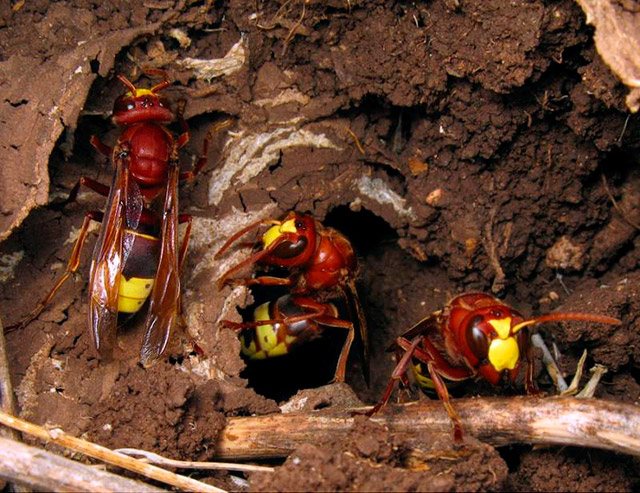

The wintering place should be such that the pregnant female (namely, in this form they sleep), falling into suspended animation, is completely safe. Enemies, cold winds, and most importantly, people should not find her. Hollows, cracks in rocks, various small cavities on the outside of human dwellings, unheated buildings, shelters under stones, fallen trunks, etc. are suitable for this.
None of the wintering insects hide inside human houses. The fact is that with the onset of cold weather, when the temperature drops below 0 ° C, the water in the insects should freeze. However, this does not happen, because in the body of these creatures, water is replaced by glycerin, which inhibits all life processes, but most importantly, it does not turn into ice and does not break cell walls.
First aid what to do after a bite
To provide proper help with a wasp sting, you need to make sure that this particular insect stung. Try not to panic, but to recognize who exactly bit you: a wasp or a bee? It depends on whether you need to look for a sting, and what treatment to choose. Look at the photo below: these relatives, although similar, have clear external differences. In a bee, the whole body is covered with villi, and the wasp is smoother and has a characteristic "wasp waist".
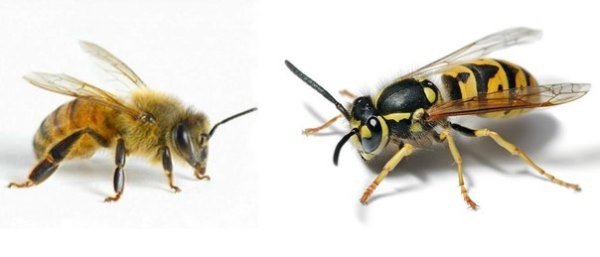

Symptoms of a bee or wasp sting are similar and difficult to distinguish, but treatment may differ, albeit slightly. Remember: if you have been bitten by a wasp, then it is pointless to look for a sting: it does not leave it in the body, but flies away, injecting poison. Treatment also depends on where the insect stung. On the legs and arms, bites cause slight discomfort in the form of itching and swelling. A bite in the neck or eye can be more painful.
It is necessary to start treatment as soon as possible. The first time after the bite, it is advisable to be at rest. Itching and painful sensations cause serious stress to the body, and it is undesirable to endure this nuisance on the legs. So the patient needs to take a horizontal position and try to relax. Also, the victim needs to drink plenty of fluids: warm tea or mineral water is optimal.
Remember that the consequences of such a bite can be unpredictable, so you need to treat it immediately. There is no time to waste before the ambulance arrives, so you will have to provide first aid yourself. First, disinfect your skin and try to relieve swelling. Often, the victim feels unbearable itching.It is advisable to anoint the skin with an antihistamine ointment, for example, Fenistil: it will help relieve itching and allow you to treat the skin to extract the poison.


What if you are out in the field when you don't have a first aid kit with you? You should know that first aid for a wasp sting can be provided with improvised means. Plantain helps well, fortunately, it grows at every step. You can make a kind of compress from it to soothe itching and relieve swelling. You can also treat the victim with improvised means.
Folk remedies for a wasp bite
A proven folk remedy, parsley, will help eliminate the unpleasant consequences of a bite. It needs to be crushed and greased with juice or gruel on the stung place. You can reduce swelling by applying ice or a heating pad filled with cold water. The affected part of the body can be treated with strong tea leaves or aloe juice.
Dandelion juice is a good pain reliever. Its medicinal properties are due to the action of acid. To relieve pain symptoms, you can make an ointment from berry juice, sorrel or lemon - the acidic components neutralize the acidic environment of the poison. For the same purpose, you can make a compress from vinegar. A decoction of tansy is useful - it can be used to lubricate the affected area, but lotions will be even more effective.
Another popular recipe is olive oil ointment. Many people have this product on the kitchen shelf, and it is useful not only in cooking. The fatty acids in the oil soothe the skin and remove toxic substances. A little oil needs to be cooled and then anointed with the affected area. For information on how to help with a bite with garlic, see the next video of Channel One.
Hornets life
These insects, not always justifiably, are considered by people to be dangerous.
After all, these creatures will never attack a person without a real threat to their home.
But attempts to destroy the nest end in a merciless struggle. In contrast to bees, the hornet stings until the venom dries up.
Unsafe Neighbors, or Beneficial Creatures?
People are greatly affected by the attack of hornets. Their bites are quite painful. Bite poison provokes severe allergic manifestations... And a large number of them can provoke death.
Moderately aggressive - people are rarely attacked
Overnight they are useful insects, ideal architects, moderately aggressive. The crux of the matter is in the ability to treat them correctly.
Variety of species
Modern science has about 23 species of representatives of this family. They populated all of Europe. Very large populations of these creatures are found in the tropics of Asia.
In Russia they are even in Siberia. They can be found in huge quantities in the Primorsky Territory. There are many hornets in the Moscow region.
The most common and well-known species:
- European - lives throughout the territory of the Russian Federation, is distinguished by a massive body and red pigmentation on the head;
- eastern - common in Europe, Russia, Asia, Africa, has a brown body;
- Filipino - lives in the Philippines, capable of inflicting a fatal bite.
Places of settlement of hornets
Hornets accept any biotopes for living. Which, as a rule, do not coexist with human settlements or agricultural land. They are not picky about food, but they can rightfully be assigned the status of predators.
Benefits and cons for humans from the activity of hornets
Benefit: eat other insects
The nutritional base of these creatures and food for breeding are other, sometimes even from their own family, insects. They are caught by hornets in huge quantities throughout the territory near their nests. Hornets are 24/7 hard workers. Is it good or bad in terms of a person?
Destruction of garden pests
A significant help is the activity of hornets for gardening farms... In one day, a family larger than the average is capable of catching up to five hundred grams of insects.
The basis of their diet is spiders, centipedes, ants, slugs, worms. They feed a good half of the sacrificial insects to the larvae.
If you do not ruin their nest, then hornets will not attack a person without significant reasons.
War of beekeepers with hornets
Harm: eating fruit juice in the garden
Hornets are able to feed on the juice of berries and fruits. Which leads to their spoilage.
Honey bees are a true find for the family of these insects. Not only the bees themselves are a wonderful treat for hornets, but what is in the honeycomb is of great value.
If you do not notice at least one hornet in time, then this is the extermination of an entire bee family.
Wintering places
Until the first frost, life will seethe in insect nests.
Having reached a large number of sexually mature individuals, the hornets fly out and start mating.
The fate of the hornets
It so happened that males are necessary for the family only for the fertilization process. By the end of August, the female starts laying eggs. Of these, individuals of both male and female appear, which are already sexually mature. They begin the process of swarming as soon as they leave the nest.
Caring for females
The nest is safe only in late autumn
At the end of the swarming, within several days, the males die. As for the females, they do not return to their native nests. They start looking for secluded places where they will spend the winter. Fertilized individuals fall into suspended animation.
Summer residents without fear remove and scorch hornet nests in late autumn... Because they are 100% sure that there are no insects in them. These manipulations are of preventive value. For the reason that it is preferable for insects to build nests in the place of old hives.
Where do hornets winter? Hornets settle in winter in the dwellings of other insects, old stumps, tree hollows, cracks formed in tree bark, under the roofs of sheds, barns, under stones, in rock cracks, and even in rural sanitary facilities between boards. After overwintering, young females, on the eve of the new year, look for a suitable place and found a new family. Old females do not go in search of such places. They begin to scatter around the surroundings and, with the onset of the first cold days, they cease to be active, as before, freeze, and more often perish on the eve of their second winter.

